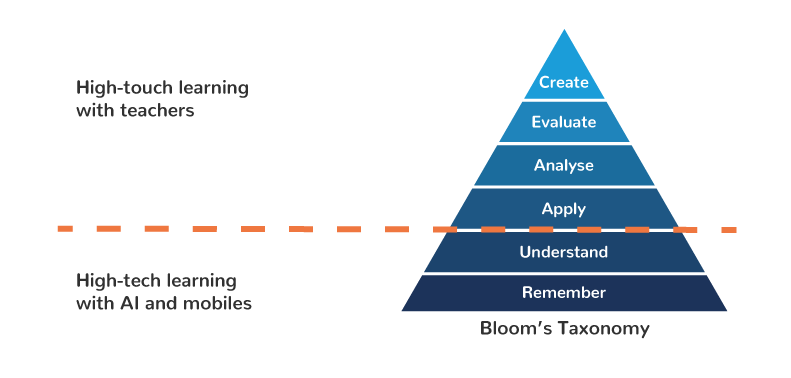The Education Commission’s Transforming the Education Workforce Report brings into stark focus the reality that, with status quo solutions, 825 million young people (roughly half) will reach adulthood without the skills they need to thrive.
The term High-Touch, High-Tech (HTHT) can be traced back to John Naisbitt’s 1982 book, Megatrends. HTHT speaks to the conscious integration of technology into our lives. Naisbitt characterises it as “embracing technology that preserves our humanness and rejecting technology that intrudes upon it.” In other words, our relationship with technology must be one of balance.
How does HTHT manifest in EdTech? The Commission’s report highlights the example of Vietnam, where the Education Workforce Initiative is partnering with the Ministry of Education and Arizona State University to develop adaptive learning courses for maths teachers and students. They describe HTHT in terms of Bloom’s taxonomy of learning objectives. The central idea is that adaptive learning technologies are poised to address the foundational layers of Bloom’s pyramid, freeing up teachers to spend more time on higher-order cognitive skills. HTHT, as it has been conceived here, promotes the importance of ‘customised’ learning for students, in both their interactions with technology (High-Tech), and with teachers (High-Touch).

This framing challenges us to reflect on where teachers’ effort is best spent. Transfer of the most routine knowledge and skills is easily outsourced to adaptive learning technologies. The full potential of these same technologies is realised only when they help teachers reorient their effort to more complex tasks like facilitating problem solving and rich classroom discussion, informed by the continuous supply of learning data generated by these systems. A commitment to customised (or personalised, individualised) learning must extend beyond the screen and empower teachers with the time and resources to tailor their instruction to the diverse needs of their students.
HTHT resonates with Whizz’s human approach to education. Adaptive learning technologies are core to our product offerings, and are supported by an understanding that the best education for any child is one which responds both to the needs of the child as an individual, and the people who make up their learning environment; parents, teachers, administrators. This understanding drives Whizz to ceaselessly innovate in understanding the processes of education and to lead the field in developing educational programmes that truly empower the stakeholders that interact with our technologies. As we scale our implementations in wide-ranging contexts across the globe, we are constantly evaluating our assumptions on how technology can augment rather than displace the most human capabilities of educators.
We are pleased with the recognition adaptive learning is getting as the definitive model for humanising the interaction of students and teachers with technology and look forward to further engagement on this topic.
